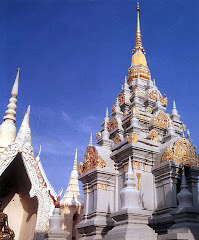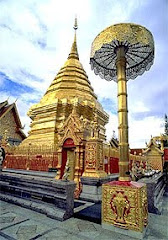
The Ubosot and Viharn are the most ornate and important buildings in a temple compound. On the outside they are decorated with stucco motifs which are covered with lacquer, glass mosaic and gilt.
An Ubosot, or consecrated ceremonial hall, is generally small for its religious functions involve only monks. The ubosot stands in consecrated ground marked by eight boundary stones. Ubosot are often locked and women are generally not allowed to enter.
The viharn is a larger assembly hall where lay people and monks participate in ceremonies. It is usually located to the east of the chedi with the front entrance facing east, the auspicious direction of the sunrise.
Though many viharn in the north are characteristically Lanna in style, details in the architectural styles have been influenced by Ayutthaya and Rattanakosin (Bangkok) styles. Taller walls in the viharn, for example, show a distinct influence of the central (Siamese) Thai. Both the ubosot and the viharn will contain the temple's most important Buddha images. During ceremonies cotton strings may be attached to these to spread the power and blessings of the image amongst devotees. Because of the value of these images and other artifacts, many viharn are kept locked except on Buddhist holy days - wan phra (monks may unlock a viharn if politely requested to do so).
The wall above the front entrance traditionally shows the unsuccessful attack by the demons of Mara, the God of Illusion who attempts to dissuade the Buddha from achieving enlightenment.
Many temples contain a small scripture repository raised up on a pedestal or stilts for protection. Known as ho trai, they are used to keep religious scripts inscribed on palm leaves. These scripts recorded Buddhist texts as well as the chronicles, which are a main source of early Thai history. One of the best examples of a ho trai is at Wat Phra Singh.Other buildings include kuti, the monks' living quarters, general purpose halls known as sala, and a bell tower which announces ritual times to monks.
Temples used to provide the only education and to this day compounds often contain schools. From ancient times the temple grounds have served as a public place for festivals and fairs. The entrances to compounds of important temples in the past would sometimes have heavily decorated entrance gates. Wat Suan Dok is the best example in Chiang Mai.
Funeral rites are held in special halls, or at the home of the deceased. Cremations are carried out at special grounds away from the temples.source: www.chiangmai1.com
Technorati tags : Chiang Mai /thai temple /wat /Thailand Temple /Chedi /Lanna Temple










No comments:
Post a Comment